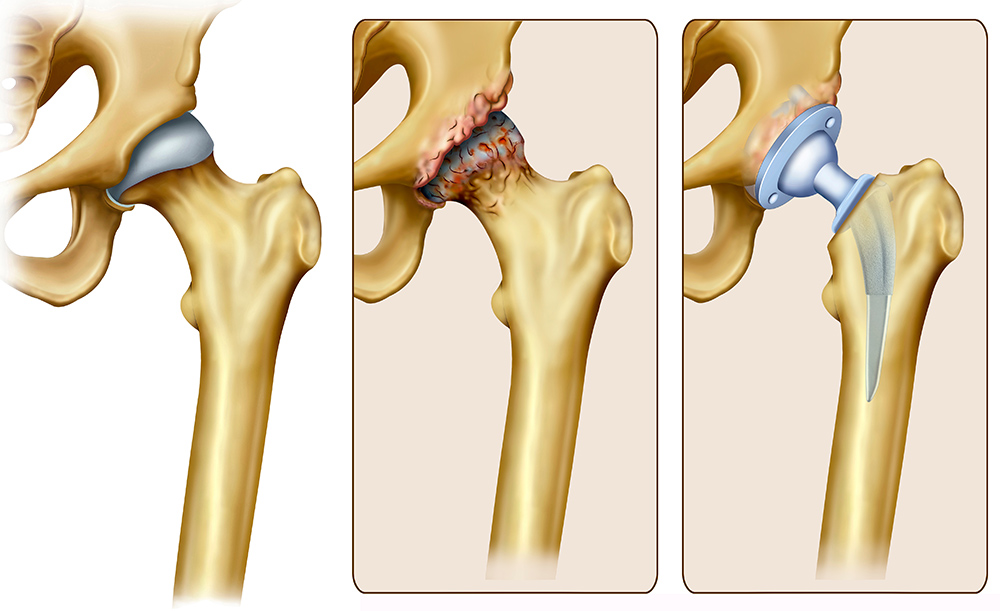Hip replacement surgery, also known as hip arthroplasty, is a surgical procedure in which part of the hip joint or the entire joint is replaced with a specially designed hip prosthesis. The hip joint plays a vital role in maintaining body balance, symmetry, and upright posture, while also allowing a high level of mobility.
With age and/or the progression of osteoporosis, bone density decreases, significantly increasing the risk of pathological fractures of the hip joint.
Types of Hip Replacement Surgery
Hip arthroplasty can be either total or partial:
- Partial hip arthroplasty replaces only the femoral head (the ball part of the joint).
- Total hip arthroplasty replaces both the femoral head and the acetabulum (the socket in the pelvic bone).
Indications for Hip Replacement
The most common indications for hip replacement in older patients include:
- Osteoarthritis (OA) – A degenerative condition of the bone and cartilage, causing pain and reduced mobility.
- Hip fractures – Breaks in the bone, most frequently occurring in patients over the age of 70, though they can occur in
- younger individuals following severe trauma.
Preoperative Assessment by an Orthopedic Specialist
As part of the preoperative evaluation, your orthopedic surgeon will:
- Conduct a thorough medical history interview to assess your overall health and identify any underlying conditions that may affect surgical preparation.
- Perform a physical examination of the hip to evaluate joint function, range of motion, and degree of damage.
- Recommend additional diagnostic tests if needed. A standard X-ray is usually sufficient, though an MRI may be used in specific cases.
Important: Smoking can negatively affect bone healing. Discontinuation of nicotine use is strongly advised at least one
month prior to surgery.
Types of Hip Prostheses
The ideal hip implant is selected based on several factors, including patient age, medical condition (injury or disease), extent of joint damage, anatomical characteristics, and personal needs.
The three main types of hip prostheses are:
- Cemented Prosthesis – Recommended for patients with reduced bone quality, often due to osteoporosis or advanced age.
- Uncemented Prosthesis – Used for patients with good bone quality; this is the most commonly used type of implant.
- Ceramic Prosthesis – A high-quality, durable, and advanced implant, offering excellent long-term performance.
How the Surgery is Performed and Duration
The earliest attempts at hip joint surgery date back to the late 19th century by German orthopedic surgeon Themistocles Glück, who used an ivory prosthesis to replace a femoral head damaged by tuberculosis.
The first total metal hip prosthesis was used in 1953 by George McKee for a femoral neck fracture.
Today, after over 70 years of advancements, hip replacement surgery is a safe, effective, and long-lasting solution** for hip joint damage.
The surgery is performed under general or spinal anesthesia.
Spinal anesthesia involves placing a catheter into the spinal column, numbing the lower half of the body. Your surgeon may also use local nerve blocks to reduce postoperative pain. The average duration of the procedure is 2–3 hours, depending on the complexity. The surgeon makes an elliptical incision to access the hip joint, removes the damaged bone and cartilage, and replaces them with a custom-fit prosthetic implant.
After surgery, patients are transferred to the recovery ward.
Postoperative Care and Recovery
To minimize the risk of thromboembolic complications and ensure optimal recovery, the following measures are taken:
- Administration of low molecular weight heparin (LMWH)
- Use of compression stockings to improve blood circulation in the legs
- Early mobilization and physical therapy starting from the first postoperative day
Average hospital stay: ~5 days (varies by patient recovery pace).

Longevity of the Hip Prosthesis
The lifespan of a hip implant depends on:
- Patient’s age at the time of surgery
- Overall health condition
- Postoperative activity level
- Implant materials
On average, patients can expect their artificial hip to last 10–15 years. Some last over 20 years, while others may require revision surgery earlier.
Life After Hip Replacement
After a successful recovery, most patients can return to light activities or office work within 6 weeks. For physically demanding jobs, recovery may take longer. Avoid high-risk activities** such as skiing or horseback riding, which may increase the risk of falls and joint injury.
Annual Number of Surgeries at Atlas General Hospital**
Each year, approximately 250 hip replacement surgeries are performed at Atlas General Hospital.
